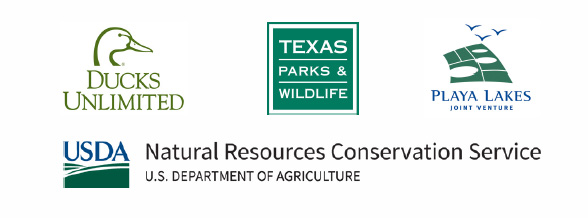Texas Playa Lakes Wetland Reserve Enhancement Partnership Program

There are approximately 23,000 playas in Texas, the highest density in North America, and mostly overlay the Ogallala aquifer (see map below). Even though they cover only 2% of the region’s landscape, playas are one of the most significant ecological features of the Southern High Plains.


Ducks Unlimited, Texas Parks & Wildlife Department, and Playa Lakes Joint Venture are working with landowners to restore and conserve 700 acres of playas and adjacent upland buffers in the Texas Panhandle. Using the USDA Natural Resources Conservation Service (NRCS) Wetland Reserve Enhancement Partnership (WREP) program, playas will be enrolled in a 30-year or permanent easement.

What are playas?
Playas — also called mud holes, buffalo wallows, and lagoons — are round, shallow depressions found at the lowest point of a watershed. They fill with water from rainstorms and run-off. These temporary wetlands provide habitat for many kinds of wildlife and recharge the Ogallala aquifer. When healthy, playas provide future water to support communities and rain-fed operations, water filtration, flood control, livestock forage, and recreation.
How are playas restored?
A healthy playa has an intact clay basin — without excavated pits or ditches — that is not buried by sediment from nearby fields. Water from the surrounding watershed freely enters the basin through a native vegetative buffer without being diverted from the playa by roads, terraces or other impediments. Playa restoration reverses past modifications to playas by removing accumulated sediment, filling drainage features, redirecting water back into the playa, and protecting the playa with an adjoining upland buffer which will be established by removing noxious and exotic vegetation, controlling erosion, and reseeding with native grassland species.
How are landowners compensated?
There are two enrollment options: a permanent easement, which is in perpetuity, and a 30-year easement that expires at the end of that time. For permanent easements, landowners receive 80% of the agricultural appraised value of acres enrolled, not to exceed $5,000 per acre. Under a 30-year easement, landowners receive 60% of the agricultural appraised value.
Who pays for the restoration cost?
Under a permanent easement, 100% of the restoration costs are paid by NRCS and other conservation partners. With a 30-year easement, landowners are responsible for paying 25% of the planned restoration cost. However, cost-share to pay for additional practices — such as fencing around the perimeter of the playa or offsite restoration activities — is often available from other agencies and conservation groups.
What can I do with the land under an easement?
Landowners retain ownership of their land and agree to follow certain land use requirements. Examples include:
- There may be changes in certain agricultural activities to protect the conservation value of the wetland.
- Grazing is often a desired management practice and may be permitted under a Compatible Use Authorization issued by NRCS.
- The rights for undeveloped recreational activities such as hiking, bird watching, hunting, and fishing may be leased.
- The land under the easement is evaluated annually to ensure both the landowner’s and the program’s goals are being met.
What land is eligible?
Privately held agricultural lands containing wetlands that were previously degraded and can be successfully and cost-effectively restored are eligible to enroll in the Texas Playa Lakes WREP. Applications will be prioritized based on the conserved wetland’s potential for protecting and enhancing habitat for migratory birds and other wildlife, as well as the playa’s potential for groundwater recharge to support nearby towns and
communities.
Am I eligible to participate?
USDA is an equal opportunity provider, lender and employer and recognizes the need to be inclusive of all people and ensure equitable access to services. Producers who own privately held land — including beginning producers, socially disadvantaged producers, veterans, and those with limited resources — are eligible to enroll in the Texas Playa Lakes WREP. All landowners must meet conservation compliance provisions and the adjusted gross income (AGI) limitations. Contact your local USDA office for more information on compliance provisions and AGI limitations.
Is there an application deadline?
WREP applications will be accepted year-round, with funding provided through a competitive evaluation process. State-specific application ranking dates are set yearly to evaluate applications for funding.
Learn More
For more information about playas, visit PlayasWorkForTexans.com. To discuss the Texas Playa Lakes WREP program and how it can support your operation and goals, call us today!
STEPHEN ROCKWOOD, Ducks Unlimited
772-532-5171 | [email protected]
HEATHER JOHNSON, Texas Parks & Wildlife Department
806-475-1308 | [email protected]


